CLASS 10th Math, Pair f Linear Equation in Two Variables (NCERT)
Exercise: 3.1 (Solution), Question-1 to Question-3
Exercise: 3.2 (Solution), Question-1 to Question-7
;;;;;;;;;;;;;;;;;;;;;;;;;;;;;;;;;;;;;;;;;;;;;;;;;;;;;;;;;;;;;;;;;;;;;;;;;;;;;;;;;;;;;;;;;;;;;;;;;;;;;;;;;;;;;;;;;;;;;;;;;;;;;;;;;;;;;;;;;;;;;;;;;;;;;;;;;;;;;
Q1. Aftab tells his daughter, “Seven years ago, I was seven times as old as you were then. Also, three years from now, I shall be three times as old as you will be.” (Isn’t this interesting?) Represent this situation algebraically and graphically.
Solutions:- Let the present age of Aftab be ‘x’.
And, the present age of his daughter be ‘y’.
Now, we can write, seven years ago,
Age of Aftab = x – 7
Age of his daughter = y – 7
According to the question,
x−7 = 7(y−7)
⇒ x−7 = 7y−49
⇒ x−7y = −42 ………………………(i)
Also, three years from now or after three years,
Age of Aftab will become = x + 3.
Age of his daughter will become = y + 3
According to the situation given,
x+3 = 3(y+3)
⇒x+3 = 3y+9
⇒x−3y = 6 …………..…………………(ii)
Subtracting equation (i) from equation (ii) we have
(x−3y)−(x−7y) = 6−(−42)
⇒−3y+7y=6+42
⇒4y=48
⇒y=12
The algebraic equation is represented by
x−7y = −42
x−3y = 6
For, x−7y =−42 or x = −42+7y
The solution table is

For, x−3y=6 or x=6+3y
The solution table is

The grapmathematicsraj1.blogspot.comhical representation is:
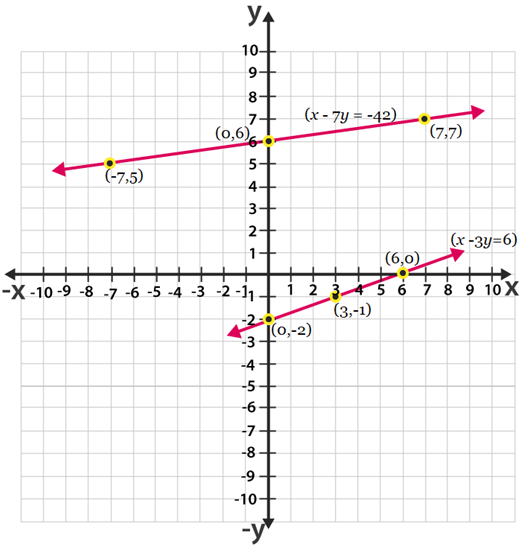
Q2. The coach of a cricket team buys 3 bats and 6 balls for Rs.3900. Later, she buys another bat and 3 more balls of the same kind for Rs.1300. Represent this situation algebraically and geometrically.
Solutions:- Let us assume that the cost of a bat be ‘Rs x’
And,the cost of a ball be ‘Rs y’
According to the question, the algebraic representation is
3x+6y=3900
and x+2y=1300
For, 3x+6y=3900
Or x = Or x =
The solution table is
| x | 300 | 100 | -100 |
| y | 500 | 600 | 700 |
For, x+2y=1300
Or x=1300-2y
The solution table is
| x | 300 | 100 | -100 |
| y | 500 | 600 | 700 |
The graphical representation is as follows.
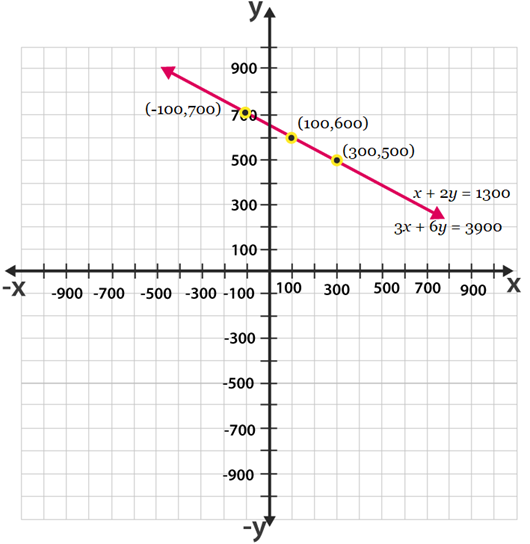
Q3. The cost of 2 kg of apples and 1kg of grapes on a day was found to be Rs.160. After a month, the cost of 4 kg of apples and 2 kg of grapes is Rs.300. Represent the situation algebraically and geometrically.
Solutions:- Let the cost of 1 kg of apples be ‘Rs. x’
And, cost of 1 kg of grapes be ‘Rs. y’
According to the question, the algebraic representation is
2x+y=160
And 4x+2y=300
For, 2x+y=160 or y=160−2x, the solution table is;
| x | 50 | 60 | 70 |
| y | 60 | 40 | 20 |
For 4x+2y=300 or y =
| x | 70 | 80 | 75 |
| y | 10 | -10 | 0 |
The graphical representation is as follows;

.................................................................................................
Exercise 3.2
Q1. Form the pair of linear equations in the following problems, and find their solutions graphically.
(i) 10 students of Class X took part in a Mathematics quiz. If the number of girls is 4 more than the number of boys, find the number of boys and girls who took part in the quiz.
(ii) 5 pencils and 7 pens together cost ` 50, whereas 7 pencils and 5 pens together cost ` 46. Find the cost of one pencil and that of one pen.
Solution:-
(i) Let there are x number of girls and y number of boys. As per the given question, the algebraic expression can be represented as follows.
x + y = 10
x – y = 4
Now, for x + y = 10 or x=10−y, the solutions are;
| x | 5 | 4 | 6 |
| y | 5 | 6 | 4 |
For x – y = 4 or x = 4 + y, the solutions are;
| x | 4 | 5 | 3 |
| y | 0 | 1 | -1 |
The graphical representation is as follows;
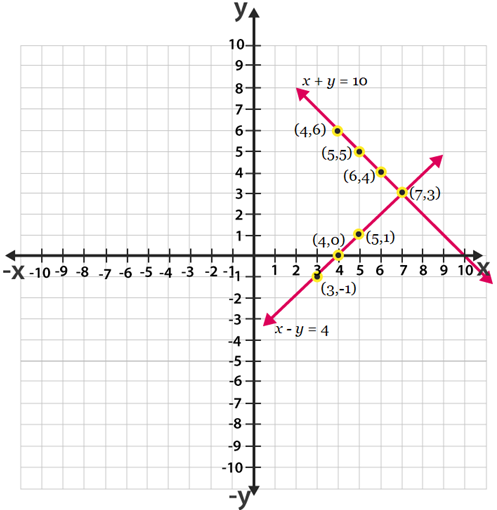
From the graph, it can be seen that the given lines cross each other at point (7, 3). Therefore, there are 7 girls and 3 boys in the class.
(ii) Let 1 pencil costs Rs.x and 1 pen costs Rs.y.
According to the question, the algebraic expression cab be represented as;
5x + 7y = 50
7x + 5y = 46
For, 5x + 7y = 50 or x =
| x | 3 | 10 | -4 |
| y | 5 | 0 | 10 |
For 7x + 5y = 46 or x =
| x | 8 | 3 | -2 |
| y | -2 | 5 | 12 |
Hence, the graphical representation is as follows;

From the graph, it is can be seen that the given lines cross each other at point (3, 5).
So, the cost of a eraser is 3/- and cost of a chocolate is 5/-.
Q2. On comparing the ratios , find out whether the lines representing the following pairs of linear equations intersect at a point, are parallel or coincident:
(i) 5x – 4y + 8 = 0
7x + 6y – 9 = 0
(ii) 9x + 3y + 12 = 0
18x + 6y + 24 = 0
(iii) 6x – 3y + 10 = 0
2x – y + 9 = 0
Solutions:-
(i) Given expressions;
5x−4y+8=0
7x+6y−9=0
Comparing these equations with a1x + b1y + c1 = 0
And a2x + b2y + c2 = 0
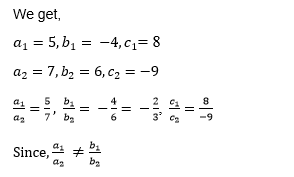
So, the pairs of equations given in the question have a unique solution and the lines cross each other at exactly one point.
(ii) Given expressions;
9x + 3y + 12 = 0
18x + 6y + 24 = 0
Comparing these equations with a1x + b1y + c1 = 0
And a2x + b2y + c2 = 0
We get,
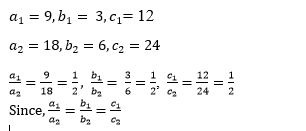
So, the pairs of equations given in the question have infinite possible solutions and the lines are coincident.
(iii) Given Expressions;
6x – 3y + 10 = 0
2x – y + 9 = 0

So, the pairs of equations given in the question are parallel to each other and the lines never intersect each other at any point and there is no possible solution for the given pair of equations.
Q3. On comparing the ratios a1/a2, b1/b2 & c1/c2 find out whether the following pair of linear equations are consistent, or inconsistent.
(i) 3x + 2y = 5 ; 2x – 3y = 7
(ii) 2x – 3y = 8 ; 4x – 6y = 9
(iii)(3/2)x+(5/3)y = 7 ; 9x – 10y = 14
(iv) 5x – 3y = 11 ; – 10x + 6y = –22
(v) (4/3)x+2y = 8; 2x + 3y = 12
Solutions:-
(i) Given : 3x + 2y = 5 or 3x + 2y -5 = 0
and 2x – 3y = 7 or 2x – 3y -7 = 0

(ii) Given 2x – 3y = 8 and 4x – 6y = 9
Therefore,

(iii) (3/2)x+(5/3)y = 7 and 9x – 10y = 14
Therefore,

So, the equations are intersecting each other at one point and they have only one possible solution. Hence, the equations are consistent.
(iv) Given, 5x – 3y = 11 and – 10x + 6y = –22
Therefore,

(v) (4/3)x+2y = 8 and 2x + 3y = 12

4. Which of the following pairs of linear equations are consistent/inconsistent? If consistent, obtain the solution graphically:
(i) x + y = 5, 2x + 2y = 10
(ii) x – y = 8, 3x – 3y = 16
(iii) 2x + y – 6 = 0, 4x – 2y – 4 = 0
(iv) 2x – 2y – 2 = 0, 4x – 4y – 5 = 0
Solutions:
(i) Given, x + y = 5 and 2x + 2y = 10

So, the equations are represented in graphs as follows:

From the figure, we can see, that the lines are overlapping each other.
Therefore, the equations have infinite possible solutions.
(ii) Given, x – y = 8 and 3x – 3y = 16

(iii) Given, 2x + y – 6 = 0 and 4x – 2y – 4 = 0

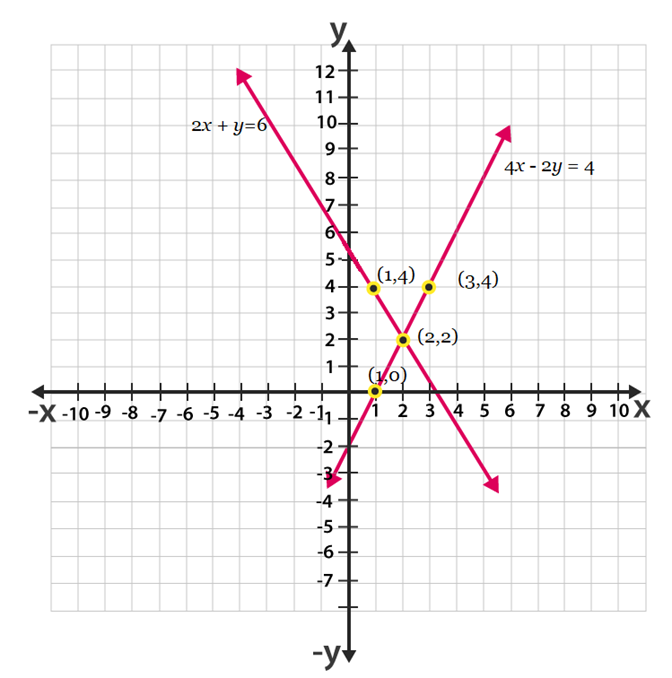
From the graph, it can be seen that these lines are intersecting each other at only one point,(2,2).
(iv) Given, 2x – 2y – 2 = 0 and 4x – 4y – 5 = 0

Thus, these linear equations have parallel and have no possible solutions. Hence, the pair of linear equations are inconsistent.
Q5. Half the perimeter of a rectangular garden, whose length is 4 m more than its width, is 36 m. Find the dimensions of the garden.
Solutions:- Let us consider.
The width of the garden is x and length is y.
Now, according to the question, we can express the given condition as;
y – x = 4
and
y + x = 36
Now, taking y – x = 4 or y = x + 4
| x | 0 | 8 | 12 |
| y | 4 | 12 | 16 |
For y + x = 36, y = 36 – x
| x | 0 | 36 | 36 |
| y | 36 | 0 | 20 |
The graphical representation of both the equation is as follows;
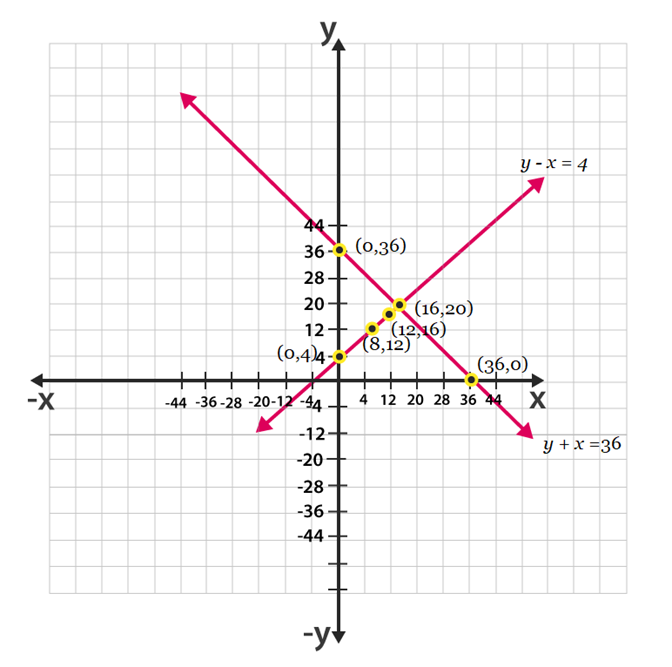
From the graph you can see, the lines intersects each other at a point(16, 20). Hence, the width of the garden is 16 and length is 20.
Q6. Given the linear equation 2x + 3y – 8 = 0, write another linear equation in two variables such that the geometrical representation of the pair so formed is:
(i) Intersecting lines
(ii) Parallel lines
(iii) Coincident lines
Solutions:
(i) Given the linear equation 2x + 3y – 8 = 0.
To find another linear equation in two variables such that the geometrical representation of the pair so formed is intersecting lines, it should satisfy below condition;

Clearly, you can see another equation satisfies the condition.
(ii) Given the linear equation 2x + 3y – 8 = 0.
To find another linear equation in two variables such that the geometrical representation of the pair so formed is parallel lines, it should satisfy below condition;

Clearly, you can see another equation satisfies the condition.
(iii) Given the linear equation 2x + 3y – 8 = 0.
To find another linear equation in two variables such that the geometrical representation of the pair so formed is coincident lines, it should satisfy below condition;

Clearly, you can see another equation satisfies the condition.
Q7. Draw the graphs of the equations x – y + 1 = 0 and 3x + 2y – 12 = 0. Determine the coordinates of the vertices of the triangle formed by these lines and the x-axis, and shade the triangular region.
Solution:- Given, the equations for graphs are x – y + 1 = 0 and 3x + 2y – 12 = 0.
For, x – y + 1 = 0 or x = 1+y
| x | 0 | 1 | 2 |
| y | 1 | 2 | 3 |
For, 3x + 2y – 12 = 0 or x =
| x | 4 | 2 | 0 |
| y | 0 | 3 | 6 |
Hence, the graphical representation of these equations is as follows;

From the figure, it can be seen that these lines are intersecting each other at point (2, 3) and x-axis at (−1, 0) and (4, 0). Therefore, the vertices of the triangle are (2, 3), (−1, 0), and (4, 0).
See next blog for more Solutions... Thank you.









